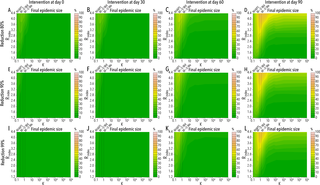PLOS Neglected Tropical Diseases ( IF 3.4 ) Pub Date : 2017-09-14 , DOI: 10.1371/journal.pntd.0005851 Marco Ajelli 1, 2 , Imelda K Moise 3, 4 , Tricia Caroline S G Hutchings 3 , Scott C Brown 4, 5 , Naresh Kumar 4 , Neil F Johnson 6 , John C Beier 4

|
Background
Zika virus transmission dynamics in urban environments follow a complex spatiotemporal pattern that appears unpredictable and barely related to high mosquito density areas. In this context, human activity patterns likely have a major role in Zika transmission dynamics. This paper examines the effect of host variability in the amount of time spent outdoors on Zika epidemiology in an urban environment.
Methodology/Principal findings
First, we performed a survey on time spent outdoors by residents of Miami-Dade County, Florida. Second, we analyzed both the survey and previously published national data on outdoors time in the U.S. to provide estimates of the distribution of the time spent outdoors. Third, we performed a computational modeling evaluation of Zika transmission dynamics, based on the time spent outdoors by each person. Our analysis reveals a strong heterogeneity of the host population in terms of time spent outdoors–data are well captured by skewed gamma distributions. Our model-based evaluation shows that in a heterogeneous population, Zika would cause a lower number of infections than in a more homogenous host population (up to 4-fold differences), but, at the same time, the epidemic would spread much faster. We estimated that in highly heterogeneous host populations the timing of the implementation of vector control measures is the major factor for limiting the number of Zika infections.
Conclusions/Significance
Our findings highlight the need of considering host variability in exposure time for managing mosquito-borne infections and call for the revision of the triggers for vector control strategies, which should integrate mosquito density data and human outdoor activity patterns in specific areas.
中文翻译:

宿主户外暴露变异性影响寨卡病毒的传播和传播:流行病控制的见解
背景
城市环境中的寨卡病毒传播动态遵循复杂的时空模式,这种模式似乎无法预测,并且与蚊子密度高的地区几乎没有关系。在这种情况下,人类活动模式可能在寨卡病毒传播动力学中起主要作用。本文研究了宿主变异性对城市环境中寨卡病毒流行病学的影响。
方法论/主要发现
首先,我们对佛罗里达州迈阿密戴德县居民的户外活动时间进行了调查。其次,我们分析了调查和之前公布的美国户外时间国家数据,以提供户外时间分布的估计值。第三,我们根据每个人在户外花费的时间对寨卡病毒传播动力学进行了计算建模评估。我们的分析揭示了宿主种群在户外时间方面的强烈异质性——数据被偏斜的伽马分布很好地捕获。我们基于模型的评估表明,在异质人群中,寨卡病毒导致的感染数量低于更同质的宿主人群(差异高达 4 倍),但与此同时,流行病的传播速度会更快。
结论/意义
我们的研究结果强调了在管理蚊媒感染时需要考虑宿主暴露时间的可变性,并呼吁修订媒介控制策略的触发因素,该策略应整合特定区域的蚊子密度数据和人类户外活动模式。











































 京公网安备 11010802027423号
京公网安备 11010802027423号